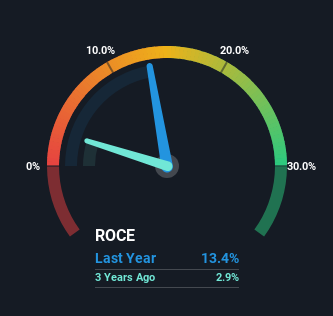- United States
- /
- Luxury
- /
- NYSE:SKX
Here's What's Concerning About Skechers U.S.A's (NYSE:SKX) Returns On Capital

What are the early trends we should look for to identify a stock that could multiply in value over the long term? In a perfect world, we'd like to see a company investing more capital into its business and ideally the returns earned from that capital are also increasing. Basically this means that a company has profitable initiatives that it can continue to reinvest in, which is a trait of a compounding machine. Having said that, from a first glance at Skechers U.S.A (NYSE:SKX) we aren't jumping out of our chairs at how returns are trending, but let's have a deeper look.
Understanding Return On Capital Employed (ROCE)
For those who don't know, ROCE is a measure of a company's yearly pre-tax profit (its return), relative to the capital employed in the business. The formula for this calculation on Skechers U.S.A is:
Return on Capital Employed = Earnings Before Interest and Tax (EBIT) ÷ (Total Assets - Current Liabilities)
0.13 = US$786m ÷ (US$7.5b - US$1.7b) (Based on the trailing twelve months to December 2023).
Thus, Skechers U.S.A has an ROCE of 13%. That's a relatively normal return on capital, and it's around the 12% generated by the Luxury industry.
Check out our latest analysis for Skechers U.S.A

Above you can see how the current ROCE for Skechers U.S.A compares to its prior returns on capital, but there's only so much you can tell from the past. If you'd like, you can check out the forecasts from the analysts covering Skechers U.S.A for free.
What The Trend Of ROCE Can Tell Us
On the surface, the trend of ROCE at Skechers U.S.A doesn't inspire confidence. To be more specific, ROCE has fallen from 18% over the last five years. On the other hand, the company has been employing more capital without a corresponding improvement in sales in the last year, which could suggest these investments are longer term plays. It may take some time before the company starts to see any change in earnings from these investments.
In Conclusion...
To conclude, we've found that Skechers U.S.A is reinvesting in the business, but returns have been falling. Since the stock has gained an impressive 81% over the last five years, investors must think there's better things to come. However, unless these underlying trends turn more positive, we wouldn't get our hopes up too high.
Skechers U.S.A does have some risks though, and we've spotted 1 warning sign for Skechers U.S.A that you might be interested in.
While Skechers U.S.A isn't earning the highest return, check out this free list of companies that are earning high returns on equity with solid balance sheets.
New: Manage All Your Stock Portfolios in One Place
We've created the ultimate portfolio companion for stock investors, and it's free.
• Connect an unlimited number of Portfolios and see your total in one currency
• Be alerted to new Warning Signs or Risks via email or mobile
• Track the Fair Value of your stocks
Have feedback on this article? Concerned about the content? Get in touch with us directly. Alternatively, email editorial-team (at) simplywallst.com.
This article by Simply Wall St is general in nature. We provide commentary based on historical data and analyst forecasts only using an unbiased methodology and our articles are not intended to be financial advice. It does not constitute a recommendation to buy or sell any stock, and does not take account of your objectives, or your financial situation. We aim to bring you long-term focused analysis driven by fundamental data. Note that our analysis may not factor in the latest price-sensitive company announcements or qualitative material. Simply Wall St has no position in any stocks mentioned.
About NYSE:SKX
Skechers U.S.A
Designs, develops, markets, and distributes footwear for men, women, and children worldwide.
Very undervalued with adequate balance sheet.
Similar Companies
Market Insights
Community Narratives




